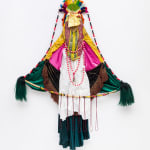Novíssimo Edgar
Manto Egungun de Favela ou Parangolé Tupinambá, 2023
ofá, berimbau, peruca, pirita, miçanga, guia de Exu, tecido de Bangladesh, máscara de diablo Huma
[ofá, berimbau, wig, pyrite, beads, Exu guide, Bangladeshi fabric, Diablo Huma mask]
[ofá, berimbau, wig, pyrite, beads, Exu guide, Bangladeshi fabric, Diablo Huma mask]
220 x 156 cm
[86 5/8 x 61 3/8 in]
[86 5/8 x 61 3/8 in]
Copyright O Artista
Mais imagens
-
(View a larger image of thumbnail 1
)

-
(View a larger image of thumbnail 2
)

-
(View a larger image of thumbnail 3
)

-
(View a larger image of thumbnail 4
)

-
(View a larger image of thumbnail 5
)

-
(View a larger image of thumbnail 6
)

-
(View a larger image of thumbnail 7
)

-
(View a larger image of thumbnail 8
)

Os rituais Africanos influenciam muitas manifestações culturais ao redor do mundo, incluindo as brasileiras. Na Ilha de Itaparica, na Bahia, Egungun é cultuado. Existem apenas cinco mantos Tupinambá e nenhum...
Os rituais Africanos influenciam muitas manifestações culturais ao redor do mundo, incluindo as brasileiras. Na Ilha de Itaparica, na Bahia, Egungun é cultuado. Existem apenas cinco mantos Tupinambá e nenhum deles está no Brasil. A questão da apropriação e da colonização cultural, estética e histórica se faz presente. Assim como o Parangolé de Hélio Oiticica apresenta semelhanças ritualísticas dentro das suas práticas festivas, o manto forma uma comunicação com o divino. Estes patrimônios históricos são prova da riqueza da cultura brasileira e da sua conexão com a herança africana e com as origens das muitas etnias indígenas que ainda resistem na sua luta pela demarcação das terras. Inicialmente, esta peça foi concebida como indumentária para apresentações musicais e artísticas que se deram em festivais ao redor do globo. Agora, a partir do imaginário coletivo das pessoas que participaram destas performances, ela se transforma em manto imaculado.
African rituals influence many cultural manifestations around the world, including Brazilian ones. On the island of Itaparica, in Bahia, Egungun is revered. There are only five Tupinambá mantles and none of them are in Brazil. The issue of appropriation and cultural, aesthetic and historical colonization is present. Just as Hélio Oiticica's Parangolé presents ritualistic similarities within its festive practices, the mantle forms a communication with the divine. These historic assets are proof of the richness of Brazilian culture and its connection with the African heritage and with the origins of the many indigenous ethnic groups that still resist in their struggle for the demarcation of lands. Initially, this piece was conceived as clothing for musical and artistic performances that took place in festivals around the globe. Now, from the collective imagination of the people who participated in these performances, it transforms into an immaculate mantle.
African rituals influence many cultural manifestations around the world, including Brazilian ones. On the island of Itaparica, in Bahia, Egungun is revered. There are only five Tupinambá mantles and none of them are in Brazil. The issue of appropriation and cultural, aesthetic and historical colonization is present. Just as Hélio Oiticica's Parangolé presents ritualistic similarities within its festive practices, the mantle forms a communication with the divine. These historic assets are proof of the richness of Brazilian culture and its connection with the African heritage and with the origins of the many indigenous ethnic groups that still resist in their struggle for the demarcation of lands. Initially, this piece was conceived as clothing for musical and artistic performances that took place in festivals around the globe. Now, from the collective imagination of the people who participated in these performances, it transforms into an immaculate mantle.
23
de
23







